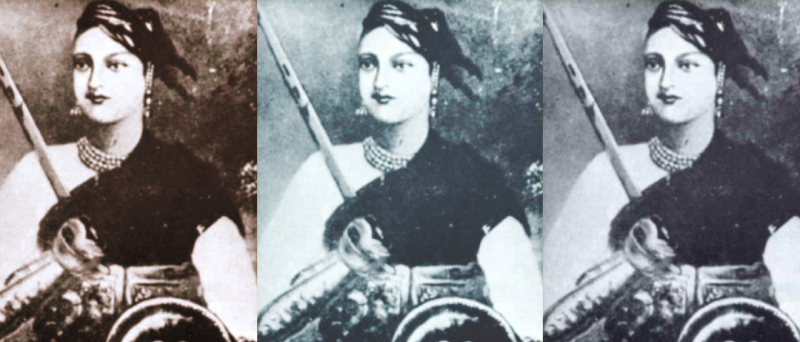The Rani of Jhansi
Posted on 3rd September 2021
The Rani of Jhansi, known to history as the ‘Warrior Queen of the Indian Mutiny’ was born Marnikarnika Bai in the town of Varanasi probably around 1828. The daughter of an important Brahmin official she was raised in the Royal Palace at Benares where her father Maropant Tambe served as a Royal Advisor..
Stories abound about the young Manu and her tomboy ways – her physical prowess and her derring-do. Some are exaggerated, others are pure legend, but it is true that she competed with the boys, excelled at sports, enjoyed the rough-and-tumble of the outdoor life and became expert at many of the more masculine pursuits.
It has also been suggested that one of her close childhood friends was Dhundu Pant, the future Nana Sahib who would be held responsible for the notorious Cawnpore Massacre. If so, then her birth date would have been much earlier than presumed, though there is little doubt that they knew one another.
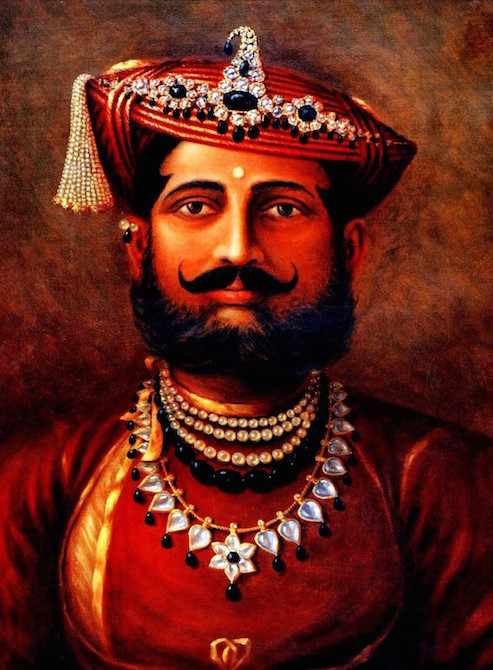
The Rajah of Jhansi was Gangadhar Rao, a softly spoken man who had little interest in politics but proved an able administrator even if it bored him beyond measure and over time the British would increasingly come to govern his Dominion for him. He much preferred to spend his time in amateur theatrics wear he would demand to play the lead female role and his love for adopting a female mien and wearing women’s clothes went beyond the stage to his Court activities where he would often be seen wearing a sari.
That he was homosexual was well known so it came as no surprise when his first wife died, she left him childless. Still, and regardless of his sexuality, it was not just his responsibility but his duty to sire an heir, and so in 1842 he was persuaded to remarry this time to a young girl in his Court known as Manukar or Manu.
It was said that this Manu was not only pretty but had masculine ways that might appeal to the mostly disinterested Rajah.
They married in great splendour and some optimism even if Gangadhar Rao never felt comfortable in his role as groom and husband and was to pay his new wife no more attention than he had his previous one.
In 1853, still childless, he fell seriously ill, and it was feared that he would die without an heir so he adopted the 5 year old Damodar Rao, a descendant of his grandfather.
He now sought reassurance from the British that, as according to Hindu law, his wife Manikarnika, now known as Lakhsmi Bai after the Goddess of Prosperity, would be accepted as Regent during his adopted son’s minority: “Should I not survive, I trust that in consideration of the fidelity I have evinced towards the British Government favour may be shown towards this child and that my widow during her lifetime may be considered the Regent of the State and mother of this child, and that she may not be molested in any way.”
No such reassurance was received before his death on 21 November,1853.

The Governor-General of India Lord Dalhousie, referencing the Policy of Lapse that had been used before as the pretext for seizing the territory of Satara declared that as there was no direct ‘male’ heir to the Throne of Jhansi that it was to be annexed by the East India Company in the name of the British Crown. This was a direct affront to the dignity of the Rani who had already been reduced according to Hindu tradition to the role of grieving widow.
If Dalhousie believed that a woman was unfit to govern then he would be proved wrong, if he thought for a moment that the Rani would simply be intimidated by the British then he was to be sorely mistaken.
Lakhsmi Bai was a woman of both intelligence and discipline; dedicated and hard-working she rose at 3.30 every morning to read documents and organise the work of the Royal Court before retiring briefly to administer to her religious duties.
She received Dalhousie’s decision to seize Jhansi from her on 15 March 1854 and reacted not just with outrage and indignation but fury crying out repeatedly: “I will not give up my Jhansi.” She proceeded to lock herself away and refused to speak to anyone or take food and water for the rest of the day. When she re-emerged from her isolation, she was in fighting mood. She could not oppose the British militarily, but she could challenge their decision through the Courts.
Her appeal which she took all the way to the High Court in London causing much frustration and delay was lost however, and she was forced to hand over not just her throne, but her jewels and the fortune left to her in her late husband’s Will. In return she was granted a pension and permitted to remain in the Royal Palace. It was little recompense for the humiliation suffered and the loss of prestige she had been forced to endure - she seethed with anger.
The disregard for both Hindu and Muslim traditions, contempt for their customs and laws, and the trampling of their sensibilities particularly in the area of religion was becoming increasingly commonplace and there was an arrogance bordering on hubris to the British presence in India.
At Meerut on 10 May 1857, it was to turn and bite them when Indian Sepoys outraged at the treatment meted out to their fellow soldiers who had refused to use cartridges alleged to be smeared in pork and beef fat mutinied and killed their Officers before rampaging through the town and killing the British in their midst. The Mutiny soon spread but in Jhansi it remained quiet and was to do so for some weeks.
That was until 4 June when encouraged by Sergeant Gurbash Singh troops of the 12th Bengal Native Infantry rebelled and without warning stormed the Star Fort killing the British and capturing its arms.
Captain Skene, who escaped the massacre, had earlier designated the nearby City Fort as a place of refuge for those Europeans and their servants in case of trouble, and some 60 people, half of them women and children, now huddled there in fear for their lives.
The only person who could save them was the Rani of Jhansi.
Captain Gordon, in command of the City Fort, despatched a letter to her but one that read more like an order than an appeal: You must take your Kingdom and hold it, along with the adjoining territory, until the British authority is established. Only then did he add, “We should also be eternally grateful if you would also protect our lives.” It was an appeal tinged with arrogance based on an assumption that could not be borne out.
The ‘authority’ that Captain Gordon wrote of was not one that she thought should run - she replied: “What can I do? If you wish to save yourself abandon the fort, no one will harm you.”
On 7 June, the fort was attacked during which Captain Gordon was killed and though the assault was repulsed it was apparent to those inside that they could not hope to resist another. The following day Captain Skene agreed to surrender the fort on the promise of safe conduct, but no sooner had they abandoned it than the Rebel Commander Risaldar Kala Khan ordered them all killed.
What role the Rani may have had in this decision remains uncertain but with only a handful of troops allowed to her by the British for her own protection there was little she could have done to prevent it. Even so, Mrs Mutlow, the Indian wife of an Englishman killed in the massacre and had been hidden by her servants claimed to have seen documents signed by the Rani authorising the massacre and showing that she had provided them with both arms and money. Other witnesses testified to having overheard her refer to the British in derogatory and blood-curdling terms.
The Rani denied all involvement and expressed regret that she had been unable to help.
She was saddened by the loss, she said, but what could she have done? She had neither the troops nor the guns and had been in as much danger as those in the fort. To the British however she appeared as the devil, apposite of everything a woman should be – devious, cruel and lacking in compassion. But she cared little of what the British thought only of what they might do.
She had every reason to be resentful, they had humiliated her, and they had stolen her Kingdom now if they chose to punish her she would fight them and regain her Jhansi by force of arms. Dr Thomas Lowe, a Medical Officer serving in India wrote of her at the time: “She is the Jezebel of India, this young, energetic, proud, unbending, uncompromising Ranee, and upon her head rests the blood of the slain, and a punishment as awful awaits her.”
For the time being at least she was in charge of Jhansi once more, but she declared neither for nor against the British instead choosing to bide her time whilst they decided her guilt or innocence. The Rani’s English lawyer John Lang provides us with a description of her: “She was about middle height, her peculiarly fine expressive eyes and very delicately shaped nose gives her countenance many charms and her complexion is fair and far from black, but what spoils her is a voice that is somewhere between a whine and a croak.”
But it was also said that her shapely face was scarred by smallpox, though some were kinder about her voice describing it as high-pitched but not offensive to the ear.
Her Court was a place of great splendour, and no expense was spared to keep it so. She wore tight fitting colourful dresses designed to show off her striking figure and adorned her body with jewels and ornaments. She was said to possess a jewel encrusted sword and when the time came to fight, she would thrust two pistols into a wide and brightly patterned cummerbund.
An expert marksman who practised target shooting everyday she could ride a horse as good as any man and rumour spread that she could ride at pace with the reins between her teeth and hit a target with both pistol and rifle. This was the stuff of legend.
When on 14 July, the Rebels left for Delhi the Rani felt secure enough to write to Major Erskine, Commissioner for the Sagarand Nerbudda territories to once again proclaim her innocence in the affair of the massacre. She had only 50 soldiers, she told him, and could not have intervened without being killed herself. Given the Rani’s character it seems unlikely that she would meekly have stepped aside allowing events to play out without making any contribution whatsoever. Nonetheless, Erskine was inclined to believe her.
When she wrote to inform Major Erskine that she had raised more troops for the protection of Company property and to secure Jhansi for the Crown and was awaiting instructions he replied entrusting the Kingdom to her care. She had played a clever game.
The new Governor-General Lord Canning was not so easily convinced however, declaring that the Rani of Jhansi’s present position and behaviour was all well and good: “Yet this current circumstance will not protect her if her account should turn out to be false.”
Unaware of the doubt still being expressed as to her loyalty the Rani restored order to Jhansi but in doing so clashed with her neighbours and soon found herself besieged for a time by troops from nearby Orcha. She wrote to Erskine requesting assistance in raising the siege. The response she got from the previously supportive Major was very different to those she had become used to, and it filled her with dread. “When the British return we will examine the conduct of all high or low, and each will be dealt with accordingly.” No assistance was forthcoming.
As the rebellion continued to spread, she procrastinated refusing to commit herself to the cause in the hope of still receiving a positive response from the British, even though she already knew in her heart that she would have to face the consequences of the earlier massacre.
In January 1858, she let it be known that she would not oppose British rule if they left her alone to govern her Kingdom and treated her with respect. When she received no reply, her mind was made up – better to die on the point of a bayonet than at the end of a rope.
She set about preparing the defences of Jhansi for the assault she knew would come and displayed no little military cunning in doing so cutting down trees and dismantling walls on the approaches to the town to provide a clear field of fire.
Her army was less impressive than it looked however, for though around 10,000 strong most were poorly armed volunteers from the city and surrounding area who had never seen fighting before and she was to become increasingly dependent upon 1500 trained Sepoys who had arrived from Afghanistan.
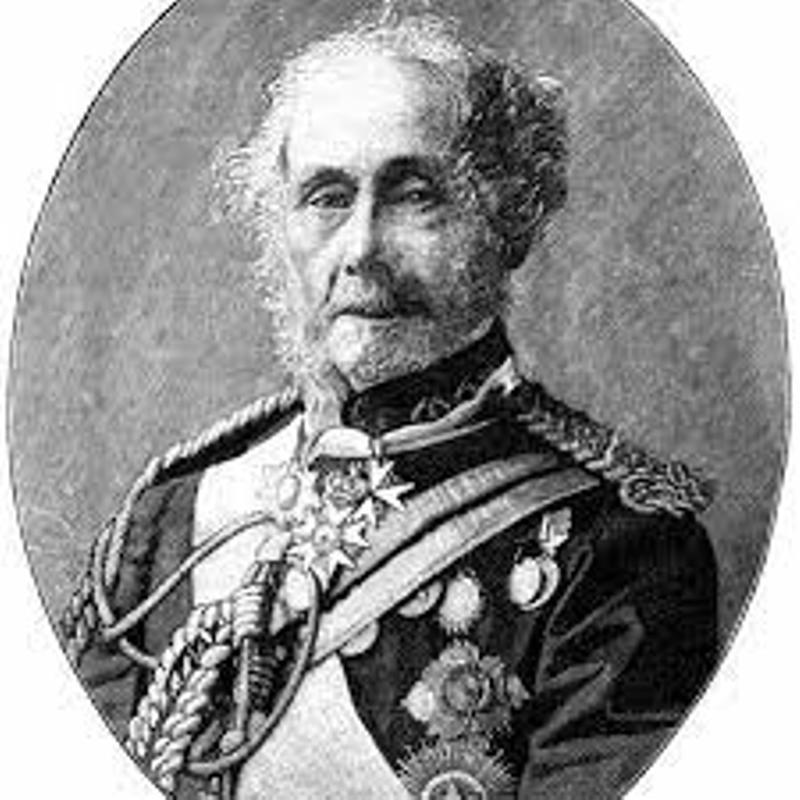
On 21 March, a British Army of 3,500 well-trained veterans armed with howitzers and field guns under the Command of Sir Hugh Rose appeared before the walls of Jhansi.
He was in no rush to assault the city even though its walls were to prove less formidable than they at first seemed. Instead he settled into a week-long bombardment designed to weaken further its crumbling defences. Jhansi’s guns, many operated by women, responded in kind but less effectively so.
On 31 March, Rose’s plans to assault the city were thrown into confusion by the unexpected arrival of Tatya Tope and 20,000 Rebel troops. The cheers and shouts of wild celebration ringing out from Jhansi’s walls could be heard for miles around, but their joy was to be premature.
Tatya Tope, always eager to engage the enemy now threw his troops headlong into the attack across the very ground that had been stripped bare of cover by the Rani and into a withering hail of musket ball and shell. He had also exposed his army to the possibility of being outflanked which General Rose now exploited.
Under intense fire and in danger of being surrounded the Rebel Army floundered, broke and fled in great disorder leaving Tatya Tope with no choice but to withdraw from the city. Once more in control of the situation General Rose continued his bombardment of Jhansi until by 2 April a significant enough breach had been made for the assault to begin
.
With most of Jhansi’s guns put out of action the British made rapid headway and despite the Rani seeming to be everywhere exhorting her troops to ever greater efforts the attack could neither be halted nor pushed back as her untrained volunteers, some of whom had never even fired their rifles before began to flee. In a last attempt to repel the invaders the Rani mounted her horse and led her Sepoys in a furious charge, but it failed with great loss of life. She now withdrew with what remained of her men to one of the city’s forts from where she had to witness her beautiful Palace being pillaged and destroyed by the avenging British and their Sepoy allies.
That night she learned that there was an unguarded gap in the British perimeter that might offer an opportunity of escape and she determined to take it. It would be a daring escape attempt reliant upon speed and stealth for success but even, so she wasn’t going to leave what remained of her worldly goods to the hated British.
In great secrecy an elephant was loaded with her baggage whilst her jewels she kept on her person as those who were to accompany her, a small number of soldiers, some loyal servants and relatives including her elderly father gathered around. Then wearing a breastplate, carrying a sword and with the 8-year-old Damadao Rao strapped to her back she mounted her horse and rode out in front.
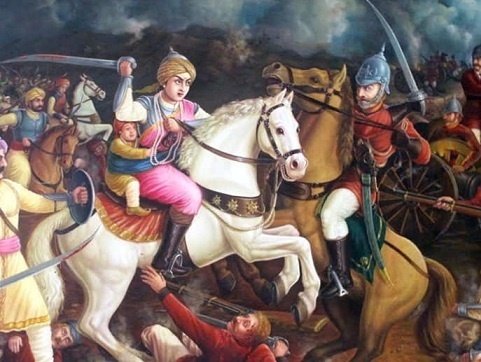
The reports she had received were accurate and there was a gap in the British lines which shrouded in darkness they were able to find a way through unseen, but they were not to go undetected for long. Under fire and pursued by cavalry she made good her escape however, but sadly her father unable to keep up could not and captured by the British he was promptly hanged from a nearby tree.
On 6 April, the Rani and her party arrived in the Rebel Camp at Kalpi where outraged that they had failed to relieve her at Jhansi she berated those she considered responsible. She then proceeded to advise Tatya Tope in tactical matters particularly the importance of guarding his army’s flanks and the importance of being aware of the enemy’s dispositions. He was offended by her temerity, but it would not be the last time he would be harangued by the Rani, neither would it be the last time he would ignore her.
Rao Sahib, the Commander of the Rebel Army in Bundelkhand learning that the Rani intended to leave the next day begged her to stay. He needed her genius and her courage he told her. If she did so, he would appoint her one of his Generals. She needed little persuading telling him: “Give me the men and I will go and fight the enemy.” But Rao Sahib was Commander in name only, he neither had the strength of character nor the energy to stand up to Tatya Tope and he resented greatly the Rani’s presence particularly now she considered herself in joint command of the army but there was little he could do.
On 23 April, the recently reinforced General Rose left Jhansi and Tatya Tope with the Rani alongside him took 10,000 men to the town of Kunch to impede his advance.
The campaign was a disaster however, with Tatya Tope once again neglecting to protect his flanks causing his army to be turned and forced to flee leaving 600 men dead and many more wounded and taken prisoner.
The Rani and Tatya Tope argued furiously over yet another military fiasco and were barely on speaking terms as they withdrew back to Kalpi.
The Rani was delighted to find in camp her old friend Nana Sahib and it came as a great comfort to be in the company once more of someone she liked and trusted. They dined together and spoke of happier times.
The Rebels, determined to hold onto Kalpi would attack the British Camp, they would, they declared, be victorious or they would die in the attempt. Before the attack began the Rani begged them not to do so over rocky, uneven terrain that would not only greatly slow the speed of their advance but provide the British with a clean sweep of the battlefield. She was right - the British artillery broke up the attack long before it ever got near their lines.
Rao Sahib plunged into despair over the defeat at Kalpi expressed his desire to give up the fight and had to have his resolve stiffened by the Rani
The Rebel Army now retreated to the State of Gwalior where they hoped to persuade the pro-British Maharatha Scindia to change sides and join them. He was reluctant to do so and inclined to resist but doubting the loyalty of his own troops he instead fled.
The Rebels entered the city of Gwalior in triumph and the Rani and Rao Sahib now took up residence in the Royal Palace where with Tatya Tope frequently absent and with the help of Nana Sahib the Rani came to increasingly dictate strategy and tactics.
But there were those among the Sepoys who resented taking orders from a woman even one with the reputation and nobility of the Rani, and so though she was listened to with apparent deference her instructions were not always carried out nor her orders obeyed.
She knew that General Rose would soon once more be upon them but the defences, she had ordered built were erected only slowly in the intense heat and when the attack finally came, they were far from complete.
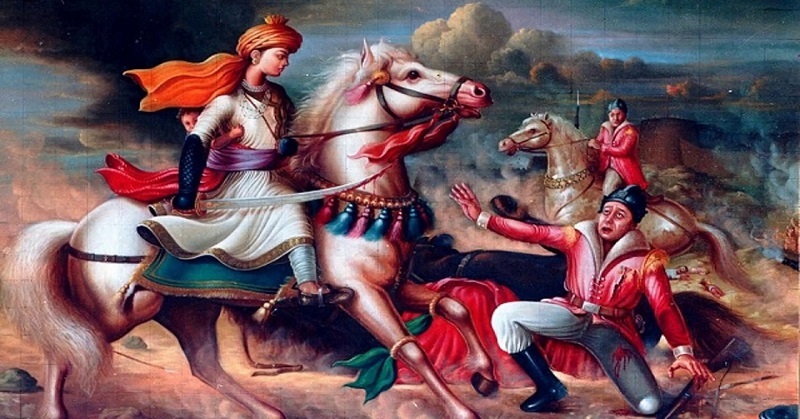
On 17 June, the Rani’s troops were subjected to a charge by the cavalry of the Irish Hussars who tore into their ranks causing panic and killing a great many. Chaos ensued as guns were captured and the men began to flee. Witnessing events, the Rani rushed to take personal command but in leading a counterattack was badly wounded by a sabre slash and after briefly swaying in the saddle was seen to fall heavily to the ground.
Flat in the dust her face covered in blood and too severely wounded to rise she pulled her pistol to fire at her assailant as he closed in but missed. He did not and she was shot dying from a single bullet wound to the chest.
The crumpled lifeless body of the Rani dressed in a Sepoy tunic, red trousers and a soldier’s boots was not even recognised to be that of a woman. Neither could her assailant have known that beneath her common army clothes she was still wearing her precious jewels.
Following her death and having witnessed her funeral carried out with the dignity due her status General Rose said of the Rani of Jhansi: “She was clever and beautiful, and the most dangerous of the Indian leaders.”
Colonel George Malleson who served in India during the Mutiny and was to later write its history was even more generous commenting:
“Whatever her faults in British eyes, her countrymen will ever remember that she was driven by ill-treatment into rebellion, and that she lived and died for her country.”
Share this post:





